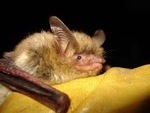For many years I thought it a novel and useful plan to incorporate bats into the ecosystem where I live. Did you know that most bats are insectivores? Moths, beetles, gnats and mosquitoes are among their favorite menu choices. Lowering my nighttime census of these insects is a popular daydream for me. Over a long time period, I studied bat environment, habitat, migration, how to attract bats and the plight of the many bats that unintentionally fall victim to a deadly fungal disease. Then at the end of one busy “day off,” after caring for vegetables, berries, garden varieties, honeybees, chickens and stray cats, I was taking a break sitting on an old fallen tree. It was interesting listening to all the “creatures of the night” as sunset gave way to darkness. Darkness in the woods has no street lights, just stars and moon light. As my eyes adjusted to the darkness, I saw activity that was grand and unmistakable: occasional wings fluttering to propel aerial acrobatics, a small flying creature the size of a swallow (but this was no swallow I have seen), was busy darting all over between the treetops almost to the ground.

Not too long ago, by accident and apparently good fortune, I dug a small pond as part of a permaculture project. This was originally intended to be a cross sectional and longitudinal study and laboratory experiment in horticultural science. Over time the pond morphed the local landscape in ways that taught me more than I could read in a book, and attracted many creatures, or critters as some people like to refer to them. Among these I have seen skunk, raccoon, fox, deer and more insects than I can count. The most useful feature is a fresh water source for the honeybees, which have a mind of their own as to what to do with habitat, and a loafing area for chickens, ducks and geese. Last but not least I suspect this environmental add-on and its ecosystem relationship attracts the bats.